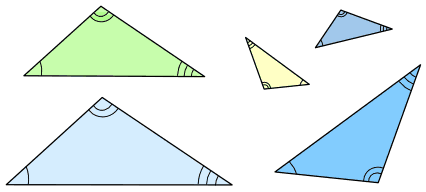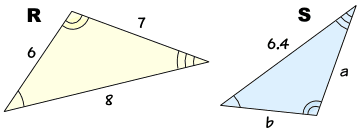Similar Triangles
Two triangles are Similar if the only difference is size (and possibly the need to turn or flip one around).
These triangles are all similar:

(Equal angles have been marked with the same number of arcs)
Some of them have different sizes and some of them have been turned or flipped.
Similar triangles have:
- all their angles equal
- corresponding sides have the same ratio
Corresponding Sides
In similar triangles, the sides facing the equal angles are always in the same ratio.
For example:

Triangles R and S are similar. The equal angles are marked with the same numbers of arcs.
What are the corresponding lengths?
- The lengths 7 and a are corresponding (they face the angle marked with one arc)
- The lengths 8 and 6.4 are corresponding (they face the angle marked with two arcs)
- The lengths 6 and b are corresponding (they face the angle marked with three arcs)
Calculating the Lengths of Corresponding Sides
It may be possible to calculate lengths we don't know yet. We need to:
- Step 1: Find the ratio of corresponding sides in pairs of similar triangles.
- Step 2: Use that ratio to find the unknown lengths.
Example: Find lengths a and b of Triangle S above.
Step 1: Find the ratio
We know all the sides in Triangle R, and
We know the side 6.4 in Triangle S
We know the side 6.4 in Triangle S
The 6.4 faces the angle marked with two arcs as does the side of length 8 in triangle R.
So we can match 6.4 with 8, and so the ratio of sides in triangle S to triangle R is:
6.4 to 8
Now we know that the lengths of sides in triangle S are all 6.4/8 times the lengths of sides in triangle R.
Step 2: Use the ratio
a faces the angle with one arc as does the side of length 7 in triangle R.
a = (6.4/8) × 7 = 5.6
b faces the angle with three arcs as does the side of length 6 in triangle R.
b = (6.4/8) × 6 = 4.8